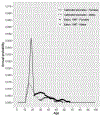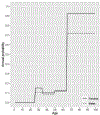U.S. Simulation of Lifetime Major Depressive Episode Prevalence and Recall Error
- PMID: 32446751
- PMCID: PMC7375917
- DOI: 10.1016/j.amepre.2020.03.021
U.S. Simulation of Lifetime Major Depressive Episode Prevalence and Recall Error
Abstract
Introduction: Simulation models can improve measurement and understanding of mental health conditions in the population. Major depressive episodes are a common and leading cause of disability but are subject to substantial recall bias in survey assessments. This study illustrates the application of a simulation model to quantify the full burden of major depressive episodes on population health in the U.S.
Methods: A compartmental model of major depressive episodes that explicitly simulates individuals' under-reporting of past episodes was developed and calibrated to 2005-2017 National Surveys on Drug Use and Health data. Parameters for incidence of a first major depressive episode and the probability of under-reporting past episodes were estimated. Analysis was conducted from 2017 to 2019.
Results: The model estimated that 30.1% of women (95% range: 29.0%-32.5%) and 17.4% of men (95% range: 16.7%-18.8%) have lifetime histories of a major depressive episode after adjusting for recall error. Among all adults, 13.1% of women (95% range: 8.1%-16.5%) and 6.6% of men (95% range: 4.0%-8.3%) failed to report a past major depressive episode. Under-reporting of a major depressive episode history in adults aged >65 years was estimated to be 70%.
Conclusions: Simulation models can address knowledge gaps in disease epidemiology and prevention and improve surveillance efforts. This model quantifies the under-reporting of major depressive episodes and provides parameter estimates for future research. After adjusting for under-reporting, 23.9% of adults have a lifetime history of major depressive episodes, which is much higher than based on self-report alone (14.0%). Far more adults would benefit from depression prevention strategies than what survey estimates suggest.
Copyright © 2020 American Journal of Preventive Medicine. Published by Elsevier Inc. All rights reserved.
Figures




References
-
- Vos T, Barber RM, Bell B, et al. Global, regional, and national incidence, prevalence, and years lived with disability for 301 acute and chronic diseases and injuries in 188 countries, 1990–2013: a systematic analysis for the Global Burden of Disease Study 2013. Lancet. 2015;386(9995):743–800. 10.1016/S0140-6736(15)60692-4. - DOI - PMC - PubMed
-
- American Psychiatric Association. Diagnostic and Statistical Manual of Mental Disorders, 5th edition Arlington, VA: American Psychiatric Association; 2013.
-
- Center for Behavioral Health Statistics, Quality Substance Abuse and Mental Health Services Administration. National Survey on Drug Use and Health (NSDUH). Rockville, MD: Center for Behavioral Health Statistics; 2017.
Publication types
MeSH terms
Grants and funding
LinkOut - more resources
Full Text Sources
Miscellaneous

